“I need to create a marketing plan template. What? Why?”
Before I hit you back with a scoop on that, a quick question.
How many times have you felt frustrated using a template that fails to serve your specific needs?
You want a certain section in your template, and it’s not there. And you end up getting frustrated and dissatisfied.
Since now you know why. Let’s not let that happen again.
Because I have a solution, with which you can create a template of your own choice. And once done properly, your efforts will be all worth it in the end.
No more setbacks, and no more rework from scratch.
Just own the template you have created and start filling in the blanks. After all, when trying to market yourself in a market, laying a blueprint of your marketing plan shouldn’t be a tough nut to crack.
In this article, I’ll take you through the key steps to creating a marketing plan template in ProofHub. With that, you’ll also find the essential elements and the step-by-step information that goes into drafting a solid and effective marketing plan.
Check out our powerful guide toknow everything about marketing workflow!
What is a marketing plan template?
A marketing plan template is a pre-designed framework outlining all the key components of your marketing plan. It is an effective way of strategizing your efforts, goals, and initiatives.
A well-structured template provides a defined set of information to be included in your plan. Businesses and marketers can use these templates to draft their plan of action. It introduces thoroughness and consistency in your actions, ensuring no information is overlooked in the process.
How to create a marketing plan template in ProofHub?
Creating a marketing plan template shouldn’t pose an additional layer of complexity to your marketing strategy. ProofHub mitigates the issue, allowing you to create a marketing plan template in a snap of time.
Let’s just take an example of creating a content marketing plan template.
To do so, follow the steps below –
- Click on the Add icon available on the right side of your Me-view. Following the step, click on the Template option from the dialogue box.
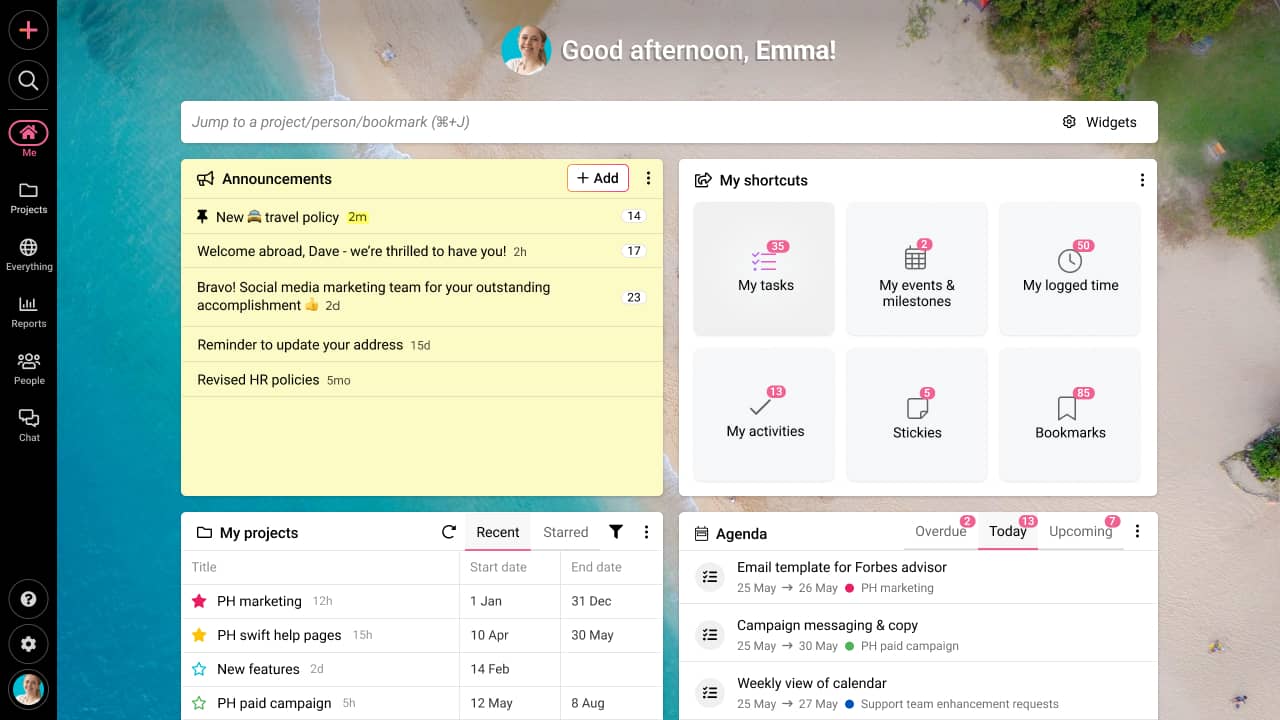
- A template dialogue box will appear, where you will need to add the Title and Description of the template. You can also select the color code of the template.
The next thing to do is add Assignees and select a Project Manager. Lastly, specify the Start date and End date of the template, and then click Next.
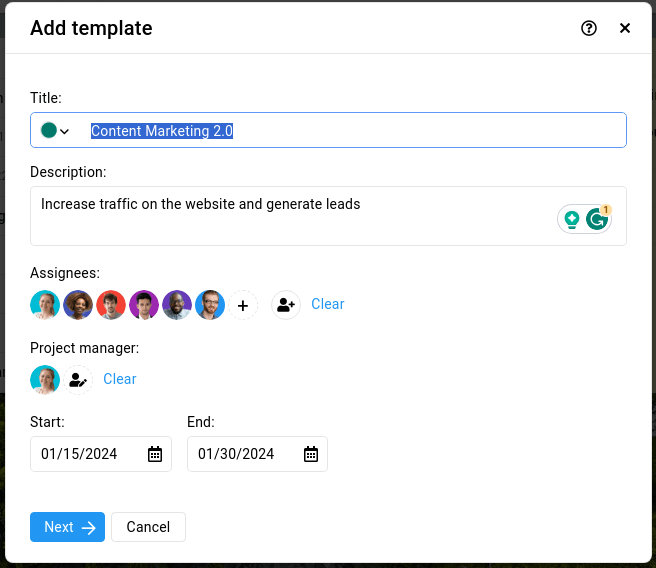
- A new dialogue box will appear, asking you to select the Tabs you want to include in your template. Selecting the parameter you want to set as default is the last thing to do before bringing it to a close.

- Your content marketing template is created. The next step is to add a task list.
Add task lists
- Now select Projects from the navigation bar, and click on Template.

- Now a new window screen will open, from which you need to select the template you have just created.

- A new screen will appear. Here, click on the add icon and then List. Or you can directly add a task list from the icon given in the center.

- Add the title name in the task list dialogue box, and select the associated workflow. You can either choose to add subscribers or keep it private as per your choice.
If you want the list to be displayed in a Gantt chart, check the box at the bottom. You can even add a milestone to add a sense of achievement to your marketing efforts.
After filling in all the details, click Add, and your task list will be created.
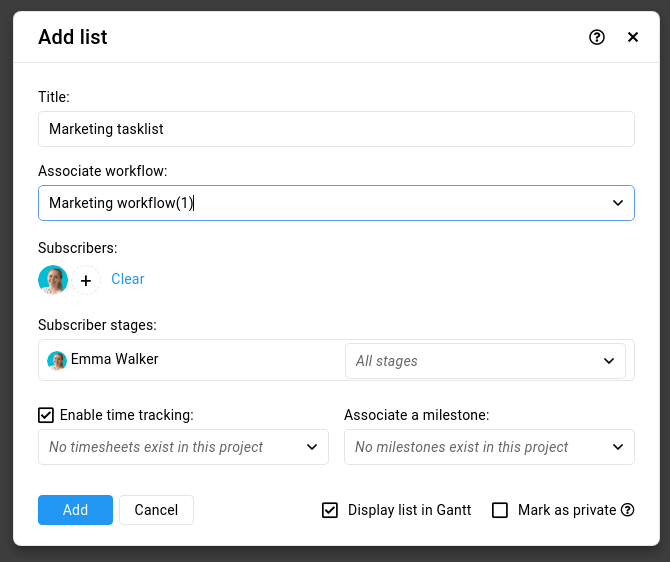
Similarly, you can add several other task lists as you want.
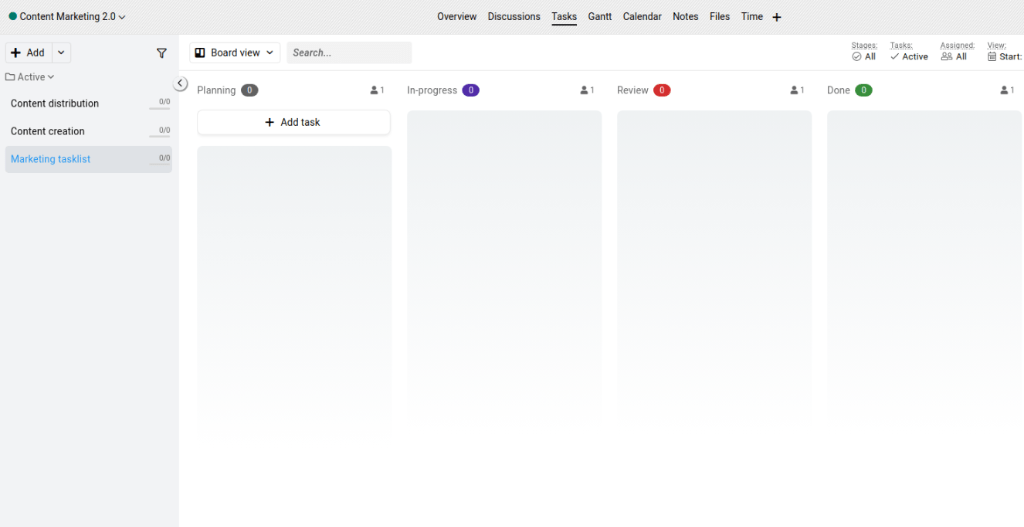
- The next thing to do is to assign, manage, and create tasks in various task lists.
Add tasks
After you are done adding your task list, start adding the
- To add a task, click on the Add icon on the top-right of your screen. Fill in your Title and Description, followed by setting deadlines and defining Task assignees. You can also choose to select labels, estimated time, or even add fields of your choice. Lastly, click on Add.
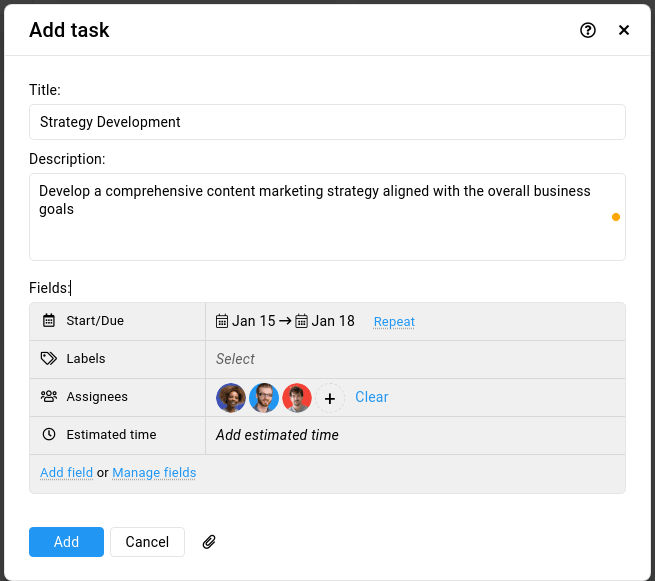
You can also choose to add tasks directly from the task list screen, using the quick add method.
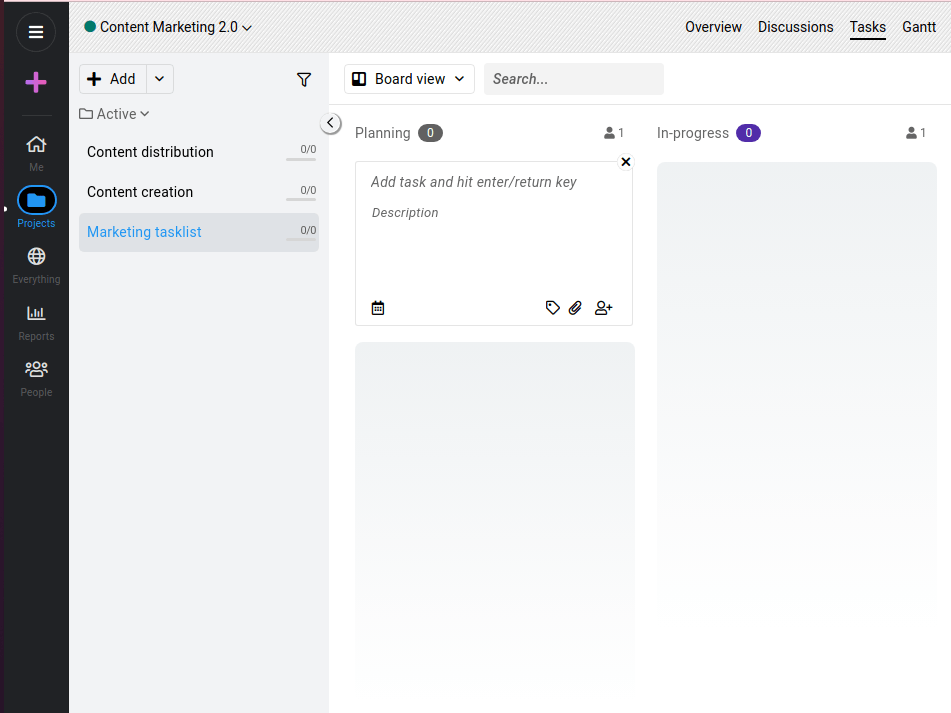
- After your task is added, select the task status.
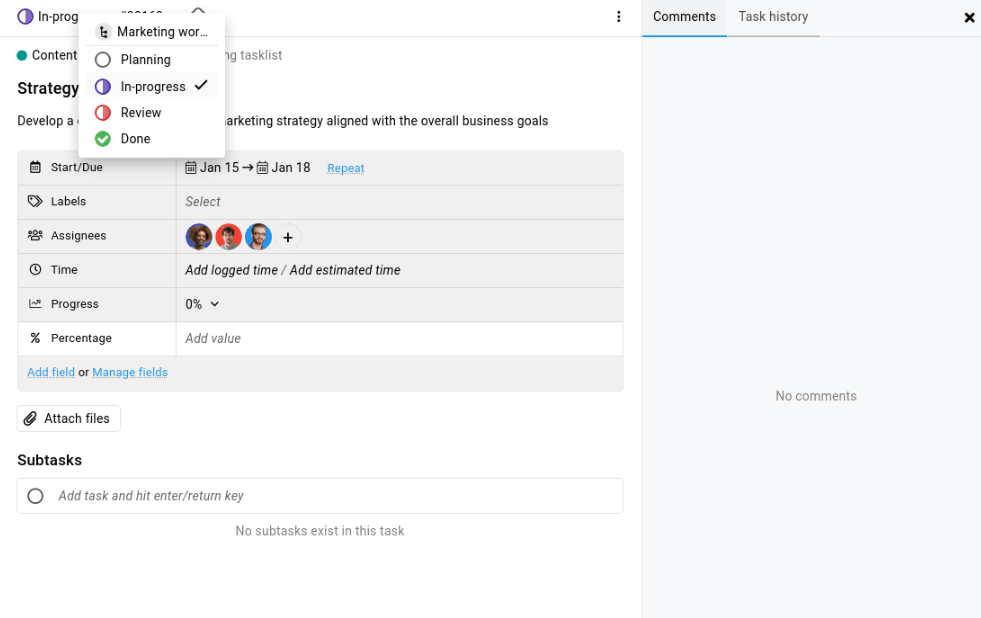
- Add your marketing tasks.
- Industry trends evaluation
- Audience research
- Strategy development.
After adding tasks, your marketing task list will look like this.
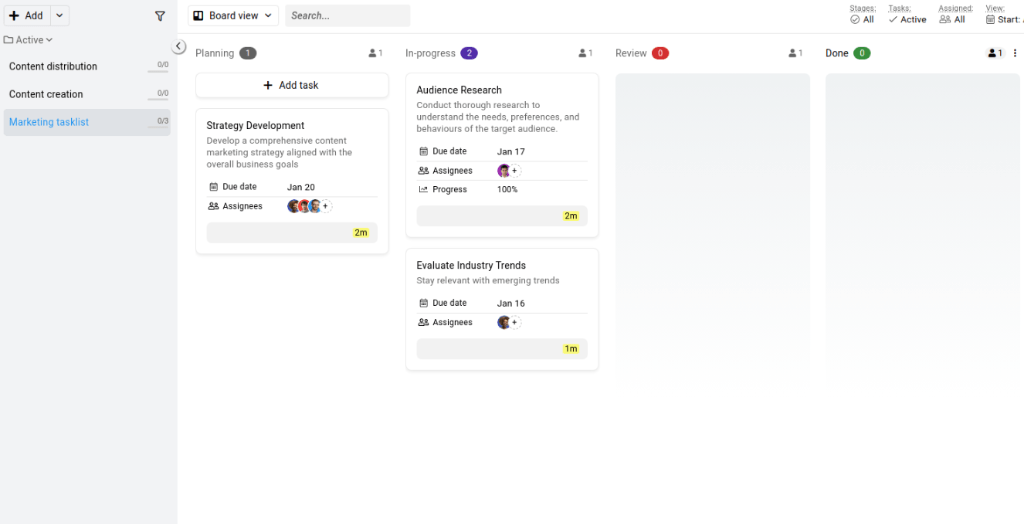
- Next, add your tasks to the content creation task list. It may include
- Creating blogs
- Creating images or infographics
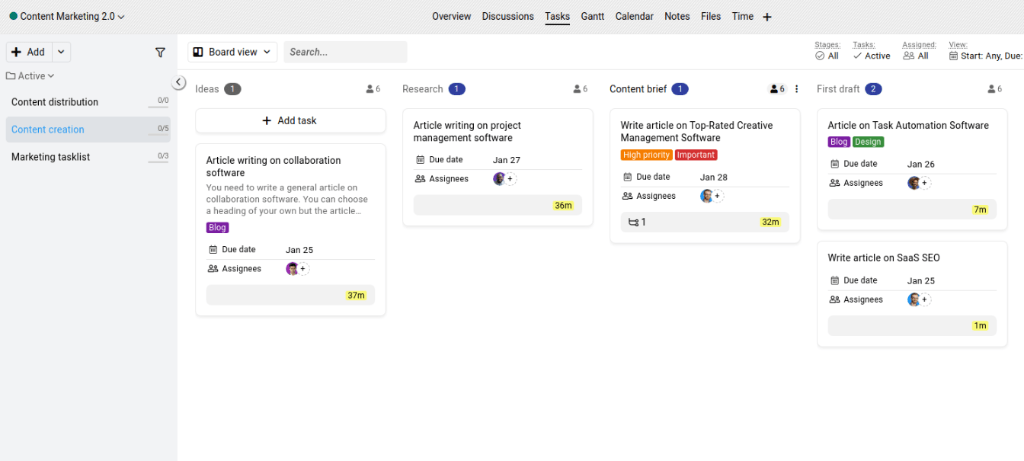
You can even add subtasks to the tasks added.
Bonus: Learn how ProofHub serves as a great content management observatory.
- Lastly, your content distribution tasklist will include tasks like:
- SEO optimization
- Schedule content calendar
- Channel selection
- Performance analysis
- Community engagement
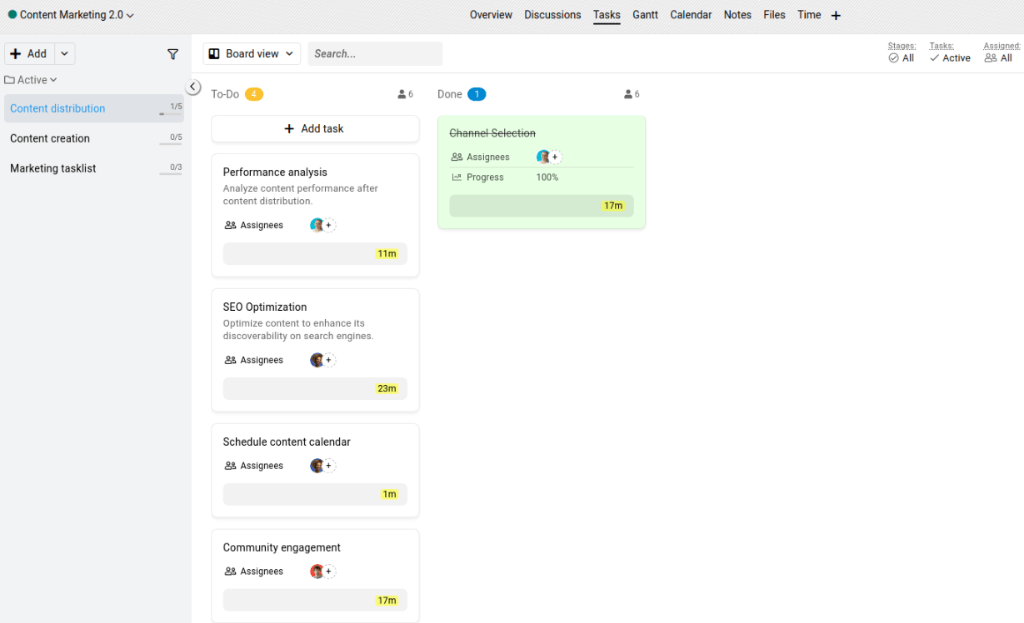
Create a project using a template
Since you already have a marketing plan template created, creating a project won’t be a big hassle the next time.
For that, all you need to do is click on the add icon, followed by selecting projects. A dialogue box will appear.
All you have to do is checklist the template box, and select the template of your choice.
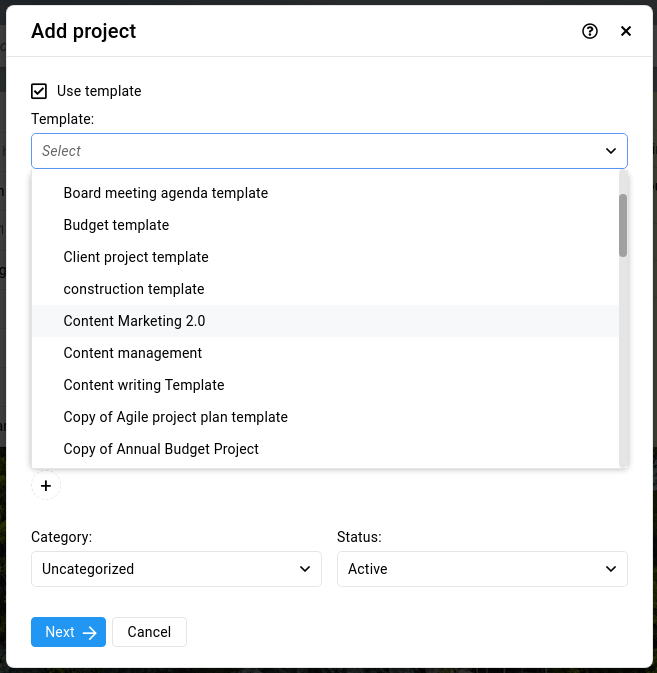
Doing so will automatically fill in all the details. You can modify this as below:
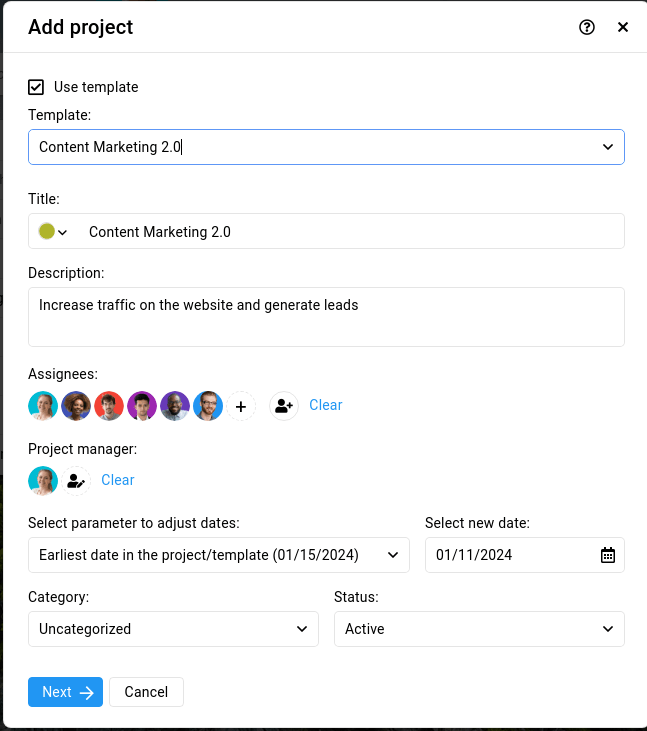
Similarly, you can outline your other marketing plans, like email marketing plans, brand awareness campaigns, social media marketing plans, and more.
What is a marketing plan?
A marketing plan is a strategic and organized blueprint of your marketing strategy. The statement acts as a single source of truth, outlining a brief overview of key components, efforts, and goals. It entails the best practices to increase brand awareness and build a reputation in your target market.
The purpose of creating a marketing plan is to ensure the plan’s alignment with your marketing objective. It helps marketing managers stay on track by providing a clear roadmap for achieving your overall mission over a certain period. There is no standard parameter, but varies depending on the budget, buyer personas, and deliverables.
What are the key elements of a successful marketing plan?
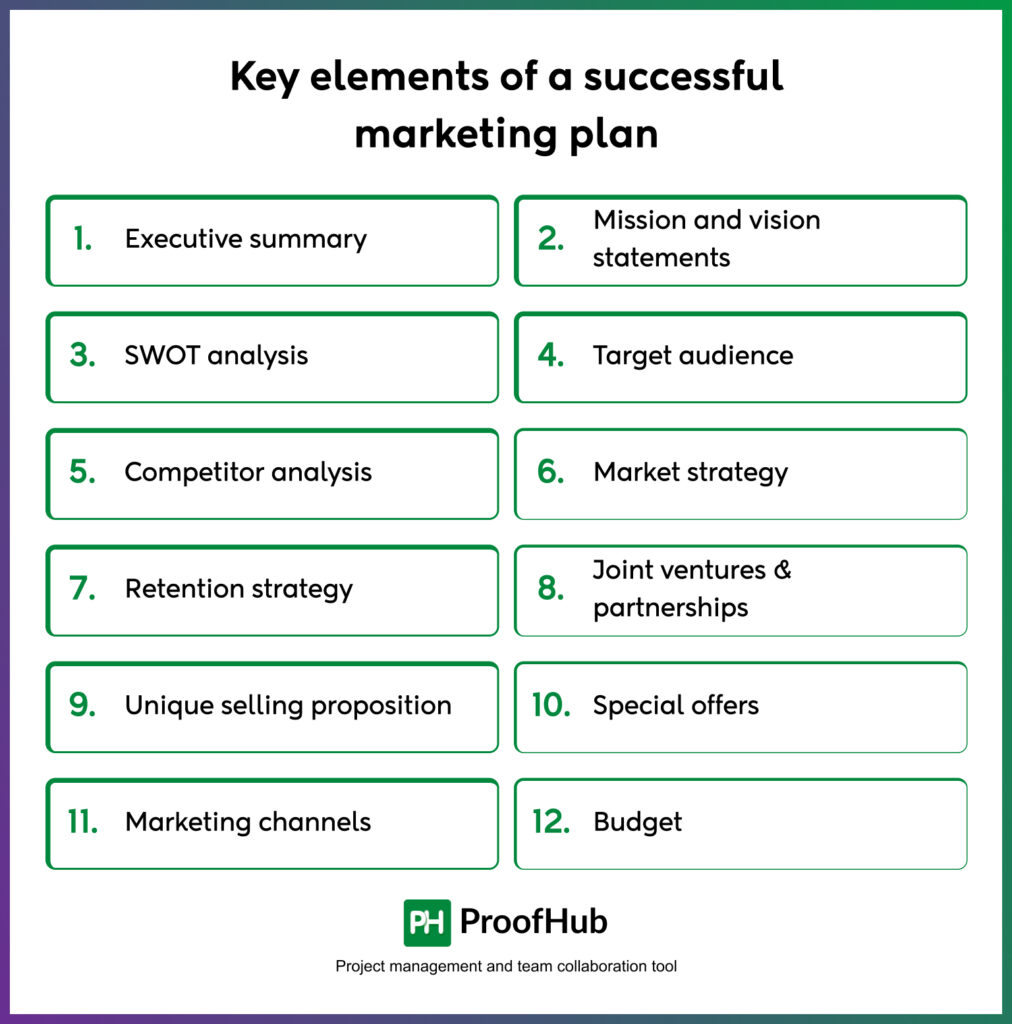
To draft a business marketing plan template, understanding the essential elements of a marketing plan becomes necessary. A right marketing plan when drafted properly becomes a testimonial of your organizational success. Some essential parameters that an effective marketing plan includes are –
1. Executive summary
As goes by the name, an executive summary is a concise yet comprehensive overview of your marketing plan. From defining your key components and objectives, the section summarizes all of your marketing plan aspects.
Consider it a direct report that provides a clear snapshot of your plan to all the individuals concerned. Be it your employees or stakeholders, it brings everyone on the same page. Despite its brief nature, the section holds great significance in defining the mission and vision of your business.
2. Mission and vision statements
After you have drafted your business summary, identifying and revisiting your business vision and mission is the next thing to do. In other words, these statements serve as the foundation for your purpose of existence and strategic planning for future initiatives.
Everyone and anyone concerned get clarity on what your business aspires to achieve and which activities you will undertake to realize your vision. These statements capture the essence of what success looks like to you in the long run.
3. SWOT analysis
A business marketing plan holds no worth if it lacks a clear identification and understanding of your business performance. Until you have an insightful metric of your business’s overall health, you cannot uncover the potential opportunities to succeed and improve.
SWOT analysis helps you perform a comprehensive analysis of your business’s strengths, weaknesses, opportunities, and threats. This step is necessary to craft your strategies in a way where you are capitalizing on your strengths and working on improving your weaknesses.
Check out our guide to get a complete overview of SWOT analysis execution.
4. Target audience
The next step in designing your marketing plan comes with identifying your buyer persona and setting your user base. By doing so you can clearly understand your target customers, and reach out to them in a preferred mode.
Considering their demographic profile (e.g., age, gender), professional profile (e.g., title, goals), psychographic profile (e.g., their interests), and their challenges and triggering events, you can segment your customer base.
5. Competitor analysis
Including a competitive analysis in your marketing plan is crucial to identify how the market is progressing. It demands solid research on your competitor’s performance to stand out confidently against your competition.
You need to keep an observant eye on what they are doing well and what they are lacking. These strategic insights can benefit you in making the most of the opportunities when the competitors fail to meet user expectations. That may include comparing pricing plans, services offered, and more.
6. Market strategy
Your market strategy is a blueprint of how you intend to promote yourself in the marketplace. However, a clear expression of your intentions and goals helps in crafting an effective plan. For instance, if you want to increase the traffic on your website from 10k to 20k, your plan then must include the ways you want to achieve that goal.
Remember that online presence is becoming a crucial component of an organization’s marketing plan. Make sure to back up your business model with online marketing strategies like search engine optimization strategies, keyword strategies, and social media strategies for better results.
7. Retention strategy
On the path to expanding your business reach, retaining customers holds more weight than acquiring new ones. A Harward Business Review study backs up the fact by stating that a new customer acquired costs 5-25 times more than retaining one with a long-term commitment with you.
By keeping retention strategies in operation, you can save significant bucks and increase your revenues and profits. Make sure to increase your customer engagement by giving them value, and encouraging them to stay longer with you.
Check out how ProofHub serves as a one-stop solution for efficient marketing plan execution.
8. Joint ventures & partnerships
Joint programs and partnerships define your collaborative agreements with other organizations to reach new customers. Influencer marketing is another form of it. It is a legal agreement formalized between two or more than two parties.
These relationships are formally structured to solidify commitment to a specific project or a specific period. In these kinds of collaborative efforts, monetizing your existing customers is another way of expanding your market reach. Both involved parties get a strategic advantage in the joint venture.
9. Unique Selling Proposition (USP)
Analyzing your unique selling proposition is one of the major marketing skills when stepping into the market. If you are unaware of your capabilities and potential, none of the above steps can do you any good. How you want to be perceived holds much significance to your existence.
It is a parameter that distinguishes you from your competitor. A customer will remember you for what sets you apart, and not merely for your functionalities.
10. Special offers
Special offers make a wonderful part of drafting your marketing plan. These help in securing and retaining customers, increasing sales, or encouraging any intended action. While your business doesn’t necessarily need to offer any special offers, opting for them just develops a sense of urgency.
These offers may take various forms, like, holiday discounts, limited-time offers, free trials, service or feature packages, flash sales, coupon codes, money-back guarantees, and more.
11. Marketing channels
With marketing efforts making their way from billboards to mobile phones in your hands, multiple marketing channels are gaining the attention of leading business agencies. Being omnipresent becomes an option no more, but the need of an hour.
Therefore, before finalizing your business plan, making a list of the channels you want to invest your efforts becomes crucial. Platforms like Instagram, Facebook, LinkedIn, YouTube, and Twitter become a gateway to reach your potential buyers and play a pivotal role in lead generation.
12. Budget
Keeping a detailed idea of how much you want to spend on marketing your business is crucial to not go impulsively. Do not confuse your marketing budget with the pricing of your product or service.
Dedicate a specific budget to your marketing team for implementing the marketing objectives and goals. Make sure to allocate the resources strategically so that it yields the expected return on investment. This may include expenses spent on, paid promotions, events, tools, etc.
Streamline your marketing process! Check out our list of top marketing project management tools.
How to create an effective marketing plan?
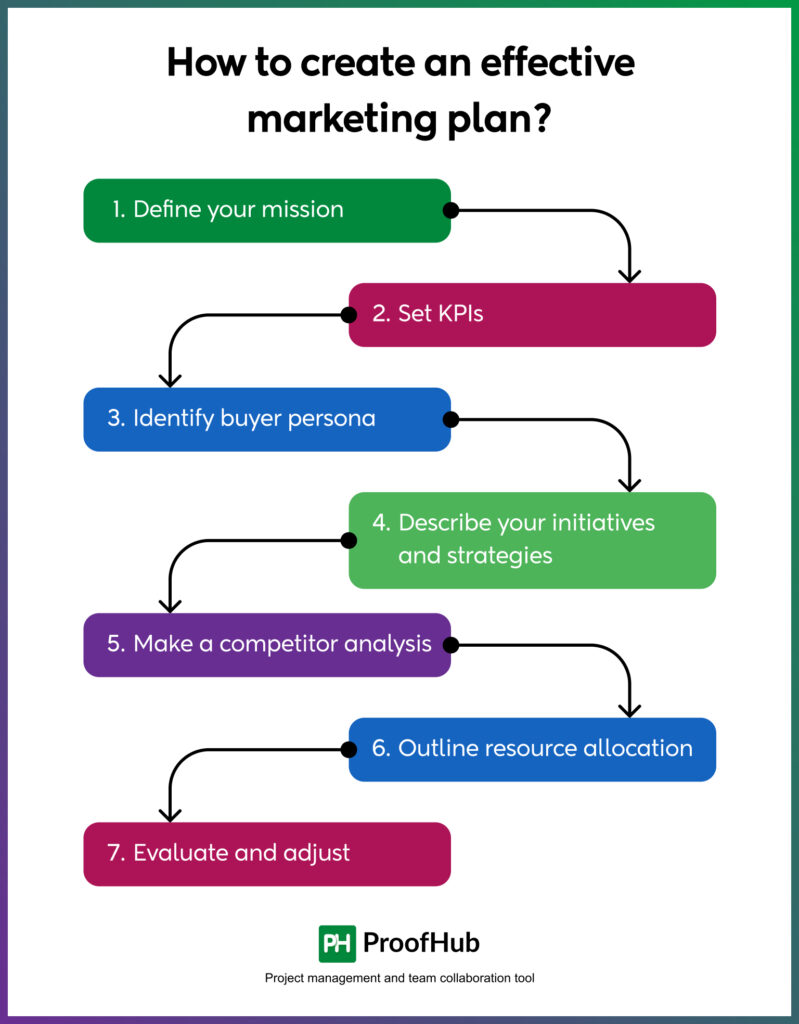
Creating an effective plan before making a business marketing plan template gives you an extra edge. It is a systematic approach that requires you to perform various actions –
1. Define your mission
When composing a marketing plan for your business, analyzing the outcome you expect from your marketing initiatives is the first thing you need to consider. The statement should bring clarity to your business objectives and operations.
Consider it like driving on an unfamiliar road with GPS guiding your way. With clear indications, you can reach your destination with little to no detours. The benefit of outlining your mission firsthand is navigating your team efforts in a shared direction of purpose.
2. Set KPIs
To measure the effectiveness of your marketing campaign, you need to define some key performance indicators. These KPIs should be specific and measurable so that you can compare your campaign results against these factors.
Defining KPIs is crucial to evaluate your campaign landscape and its potential to achieve sustainability and success. For that, you need to know your business both inside and out, ensuring a comprehensive understanding of your benchmarking metrics.
3. Identify buyer persona
To increase brand loyalty standards, you need to invest good efforts in understanding buyer persona. It brings clarity into who you want to attract and strategize your plan accordingly.
Demographic research plays a crucial role in targeting and forming the basis of where your target base is more active and approachable. You can leverage marketing channels to reach specific demographics, enhance customer experience, and influence the buyer decision process.
4. Describe your initiatives and strategies
After you’ve got a complete overview of your mission and targetted audience, defining your strategic initiatives and strategies comes the next step. This becomes the most prominent factor to drive successful market penetration.
No matter how simple it may sound, the execution takes a toll on you if not carefully planned. The circulation of the right content type on the right marketing channels drastically impacts campaign success. The strategies may include content marketing, search engine optimization, social media campaigns, and more.
5. Make a competitor analysis
If you want to get a competitive advantage in your marketing strategy, make sure to run extensive research and analysis over your opponents.
Know how your competitors are projecting themselves in the market. Identify the key players, and analyze their strengths, tactics, and weaknesses. Look out for their vulnerable points and what they are lacking. Make the most of their shortcomings by fine-tuning your strategy accordingly.
6. Outline resource allocation
With your marketing plan all laid out, allocating resources should be your next goal to start on the right foot. You must give considerable thought to your team’s strengths and capabilities.
It should also outline how they will support your marketing initiatives and what is expected of them. On rightful allocation, get your project rolling and everyone in your team into action.
7. Evaluate and adjust
Lastly, do not make the mistake of considering your marketing plan an enactment engraved on stone. Make sure to perform a marketing plan life-cycle assessment. Compare your results against established KPIs, ask for stakeholders’ feedback, and analyze customer behavior to adjust your plan accordingly.
Analyze what actions are yielding you more profits. Invest your greater efforts into it, which may require you to make some adjustments in your budget and invest more resources in that direction. After all, flexibility and adaptability are key to growing and improving in an evolving landscape.
After you are done crafting your marketing plan, designing a marketing plan template is the next right thing to do.
Read more: Keep up with your marketing metrics to meet your goals using marketing reporting.
Plan your marketing campaigns seamlessly with ProofHub
If you want to execute your company marketing plan with efficiency and precision, ProofHub gets it done with little to no hiccups. It enhances your marketing project management capabilities with its project marketing plan template while keeping your business communication and collaboration alive.
The smart platform comes in handy to save your consistent & strategic efforts from crumbling like a house of cards. From planning, managing, and tracking to goal setting and execution, ProofHub elevates user experience and business value.
Use ProofHub to introduce transparency in your marketing plan. Because when teams know what they need to do, no uncertainty can disrupt your marketing plan.
FAQs
How often should a marketing plan be updated?
Consider the marketing plan a living document that needs regular monitoring and updation during the entire lifecycle. Your marketing plan should be adaptable to accommodate and bear the consequences of any scope change.
What are the 4Ps of marketing?
The 4 main Ps of “marketing mix” are product, price, place, and promotion. Marketers and businesses use these four Ps to execute their marketing plans and appeal to their target audience.
Why do you need a marketing plan for your business?
A well-researched marketing plan lays a roadmap for your marketing efforts, objectives, and goals. A thoughtful time goes into crafting this plan, hence helping you stay focused and on track. Additionally, it ensures your team efforts remain in alignment with business initiatives.

